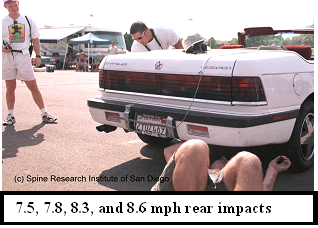Whiplash Can Occur with “SlightDamage” to the Bumper

We have already established in Trauma Series #15 that bumpers can sustain crash impacts greater than 5 mph and deform, on the average, between 8-12 mph.What is apparent, is in a rear end collision where there is no gross deformity of the bumper, there is usually slight damage in the form of paint chipping or a small dent. This is demonstrative evidence that cars collided and energy was transferred from the striking car to the car in front. Biomechanical engineers have concluded that in rear-end collisions, pent up energy in contracted bumpers and seat backs spring, being released simultaneously, as the driver in the front car reapplies the brakes and causes the occupant to be exposed to more destructive force than the car. This is the cause for whiplash in these “slight” damage crashes. The Insurance Institute for Highway Safety concurred, when Farmer, Wells and Lund researched for them in 1999 and wrote ‘when property damage was slight…neck injuries could occur
